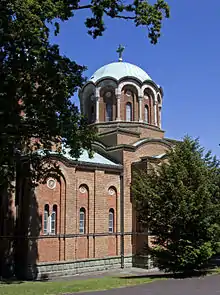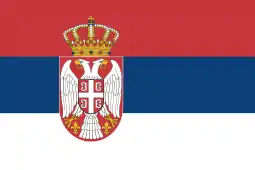Serbs in the United Kingdom
British Serbs or Serbs in the United Kingdom[1] are Serbs and people of Serbian ancestry in the United Kingdom.
 Serbian Orthodox Church of Saint Lazar in Birmingham | |
| Total population | |
|---|---|
| 70,000 ethnic Serbs (estimate) 8,391 Serbia-born residents (2011 Census) | |
| Languages | |
| English, Serbian | |
| Religion | |
| Serbian Orthodox Church |
| Part of a series of articles on |
| Serbs |
|---|
 |
Demographics
The Serbian Council of Britain notes the presence of second- and third-generation British Serbs.[2] In 2001, the Serbian Embassy estimated that there were 70,000 Serbs in the United Kingdom.[3] A January 2012 estimate claims 80,000.[4]
The 2011 UK Census, recorded 8,049 Serbian-born residents in England, 122 in Wales,[5] 188 in Scotland,[6] and 32 in Northern Ireland (a total of 8,391).[7] In response to the ethnicity question, 7,312 people in England, 106 in Wales,[8] and 185 in Scotland wrote in "Serbian" under the "White" heading, as an alternative to ticking one of the pre-defined categories.[9]
There has been a Serb community in Halifax since Yugoslavia's liberation during World War II. Monarchist refugees (Chetniks) left Yugoslavia as a result of Josip Broz Tito's revolution.[10]
There is a sizeable Serb community in Shepherd's Bush (Hammersmith and Fulham) and Notting Hill (Kensington and Chelsea) in West London, where Serbian grocery stores, cafes, and a Serbian church is present.
Organisations
There are a number of Serbian Orthodox churches in the UK, including London, Birmingham, Bradford, Halifax, Corby, Derby, Bedford, Telford, Leicester and Oxford.[11]
In 1953, an organisation which was to become the Movement of Serbian Chetniks of Ravna Gora in Great Britain[12] was established by fifty prominent Dinara Division veterans from all over England and Wales and is still active.
The Serbian Society in the UK[13] was formed in 1995 as a new influx of Serbian refugees and émigrés arrived amid the Yugoslav Wars of the 1990s. The society has a cultural focus in London. It is a registered charity.
The Serbian Council of Great Britain[14] was established in 2004 to promote the development of the community, particularly through cooperation with exiting community organisations. Since 2008, the organisation has organised Serbian Week which would broaden to become Serbian Month. Typically a series of events held from late January through to the end of February, it has become the most successful exposition of culture of its kind within the Serbian Diaspora.
In 2008, a magazine was launched for Serbs in Britain called Britic,[15] which is now online.
Notable people
Arts and entertainment
- Pete Vuckovic, singer/songwriter
- Nenad Petrović, writer
- Roksanda Ilincic, fashion designer
- Deyan Sudjic, broadcaster, director of London's Design Museum, Order of the British Empire
- Sara Brajovic, model and actress[16][17]
- Tamara Ecclestone, model and socialite[18][19]
- Petra Ecclestone, model and socialite[18][19]
- Cary Elwes, actor
- Damian Elwes, artist
- Cassian Elwes, film producer
- Tessa Kennedy, interior designer
- Lene Lovich, singer/songwriter
- Vesna Goldsworthy, author and poet
- Bobby Krlic, musician and producer
- Daniel Vivian, actor
- Zelda Tinska, actress
- Abby Rakic-Platt, actress
- Olivia Sudjic, novelist
- Vukša Veličković. journalist
- Ana Rajcevic, fashion artist
- Ana Šekularac, fashion designer[20][21]
Academia
- Vlatko Vedral, professor of physics at University of Oxford
- Stevan K. Pavlowitch, historian
- Maja Pantic, professor and A.I. expert
Sports
- Alex Bogdanović, tennis player born in Belgrade[22]
- John Lukic, former Arsenal and Leeds United goalkeeper
- Steve Ogrizovic, former Coventry City goalkeeper
- Milija Aleksic, former Tottenham goalkeeper
- Mel Pejic, former Stoke City defender
- Mike Pejic, former Everton defender
- Shaun Pejic, former Vancouver Whitecaps defender
- Simon Svabic, former professional rugby league footballer
- Liam Higgins, former professional rugby league footballer
- Marko Stanojevic, rugby union player
Other
- Milan Mandarić, businessman and owner of Sheffield Wednesday F.C.
- Nicolas Bratza, former President of the European Court of Human Rights
- Vane Ivanovic, diplomat
- Daška McLean
- Milos Stankovic, former British Army officer
See also
- Serbia – United Kingdom relations
- Serbian Orthodox Eparchy of Britain and Scandinavia
- List of Serbs
- List of Serbian Americans
- List of Serbian Canadians
References
- Pryke, Sam (2003). "British Serbs and long distance nationalism" (PDF). Ethnic and Racial Studies. 26 (1): 152–172. CiteSeerX 10.1.1.693.4235. doi:10.1080/01419870022000025315.
- "Great British Serbs". Serbian Council of Britain. Retrieved 4 January 2016.
- "So, just how many Serbs live in Britain? Britić figures defy census figures of 2001". Ebritic.com. 3 June 2011.
There have been various attempts to estimate the population of Serbs living in the UK. The simplest answer was the 2001 national census which stated that there are 31,244 UK residents born in Serbian and Montenegro. A further 6,992 were born in Croatia. However, the obvious problems are that many Serbs were born in the UK (maybe even most British Serbs). Moreover, in 2001 there were still a large number of Kosovan Albanians in Britain who would have been registered as being born in Serbia and Montenegro. The Serbian Embassy made their own estimate ten years ago and arrived at a figure of 70,000.
- Bilbija, Bojan (29 December 2013), Dijaspora može da promeni Srbiju, Politika,
procenjeno brojno stanje u januaru 2012 [estimation in January 2012]
- "2011 Census: Country of birth (expanded), regions in England and Wales". Office for National Statistics. 26 March 2013. Retrieved 4 January 2016.
- "Country of birth (detailed)" (PDF). National Records of Scotland. Retrieved 4 January 2016.
- "Country of Birth - Full Detail: QS206NI". Northern Ireland Statistics and Research Agency. Archived from the original on 4 March 2016. Retrieved 4 January 2016.
- "Table QS211EW: 2011 Census: Ethnic group (detailed), local authorities in England and Wales". Office for National Statistics. 30 January 2013. Retrieved 4 January 2016.
- "Ethnic group (detailed): All people" (PDF). National Records of Scotland. 2013. Retrieved 4 January 2016.
- Popham, Peter (26 July 1995). "A Serbian enclave in Yorkshire". The Independent. Retrieved 25 August 2010.
- "Serbian Orthodox Diocese of Great Britain and Scandinavia". Retrieved 17 April 2019.
- "Movement of Serbian Chetniks Ravna Gora in Great Britain: A Brief History". Retrieved 17 April 2019.
- "About the Serbian Society in the UK". Retrieved 17 April 2019.
- "About the Serbian Council of Great Britain". Retrieved 17 April 2019.
- "Britic - The British Serb Magazine". Retrieved 17 April 2019.
- http://www.fashionwelike.com/my-style/sara-brajovic
- https://www.vogue.fr/chloesacbaylee/diaporama/dans-le-sac-baylee-de-sara-brajovic/15765
- S., M. (14 August 2009). "Život kao bombona". Novine Toronto (in Serbian).
- Red Carpet (10 March 2008). "Video: Odakle je zapravo Slavica Ecclestone?". Dnevnik.hr (in Croatian).
- http://www.vogue.co.uk/brand/ana-sekularac
- https://www.elle.com/ana-sekularac-runway/
- "Bogdanovic reaches final". BBC Sport. 25 October 2002. Retrieved 22 November 2009.
Further reading
- Pryke, Sam (2003). "British Serbs and long distance nationalism". Ethnic and Racial Studies. 26 (1): 152–172. CiteSeerX 10.1.1.693.4235. doi:10.1080/01419870022000025315.
- "Telford, Little Yugoslavia". Four Thought. 2 September 2020. BBC. Radio 4.
